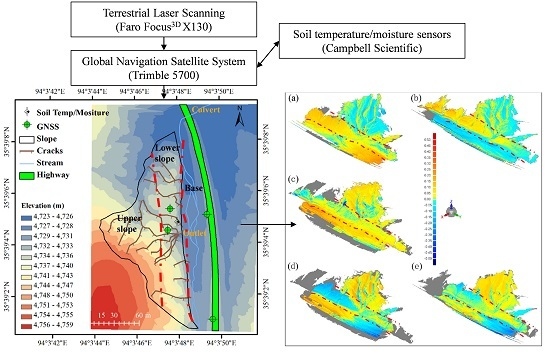Freeze/Thaw-Induced Deformation Monitoring and Assessment of the Slope in Permafrost Based on Terrestrial Laser Scanner and GNSS
Abstract
:1. Introduction
2. Materials and Methods
2.1. Study Site
2.2. Instruments
2.3. Processing on Time-Series TLS and GNSS
2.4. Data Uncertainties
3. Permafrost Dynamics
3.1. Hydrological–Thermal Dynamics
3.2. Permafrost Indices
4. Results
4.1. Deformation Analysis
4.1.1. Deformation Features during Thawing Periods
4.1.2. Deformation Features during Freezing Period
4.1.3. Deformation Features during Thaw–Freeze Cycles
4.2. Zonal Deformation Analysis
4.2.1. Deformation Features of the Upper Slope
4.2.2. Deformation Features of the Lower Slope
4.2.3. Deformation Features of the Base of Slope
5. Discussion
6. Conclusions
Acknowledgments
Author Contributions
Conflicts of Interest
References
- Huggel, C.; Salzmann, N.; Allen, S.; Caplanauerbach, J.; Fischer, L.; Haeberli, W.; Larsen, C.; Schneider, D.; Wessels, R. Recent and future warm extreme events and high-mountain slope stability. Philos. Trans. R. Soc. 2010, 368, 2435–2459. [Google Scholar] [CrossRef] [PubMed]
- Allen, S.K.; Gruber, S.; Owens, I.F. Exploring steep bedrock permafrost and its relationship with recent slope failures in the southern alps of New Zealand. Permafr. Periglac. Process. 2009, 20, 345–356. [Google Scholar] [CrossRef]
- Huggel, C. The High-Mountain Cryosphere: Environmental Changes and Human Risks; Cambridge University Press: Cambridge, UK; New York, NY, USA, 2015. [Google Scholar]
- Gruber, S.; Hoelzle, M.; Haeberli, W. Permafrost thaw and destabilization of alpine rock walls in the hot summer of 2003. Geophys. Res. Lett. 2004. [Google Scholar] [CrossRef]
- Mcroberts, E.; Morgenstern, N. Stability of slopes in frozen soil, Mackenzie Valley, N.W.T. Can. Geotech. J. 1974, 11, 554–573. [Google Scholar] [CrossRef]
- Mcroberts, E.; Morgenstern, N. The stability of thawing slopes. Can. Geotech. J. 1974, 11, 447–469. [Google Scholar] [CrossRef]
- Niu, F.J.; Cheng, G.D.; Ni, W.K.; Jin, D.W. Engineering-related slope failure in permafrost regions of the Qinghai-Tibet Plateau. Cold Reg. Sci. Technol. 2005, 42, 215–225. [Google Scholar] [CrossRef]
- Savigny, K.; Morgenstern, N. In sity creep properties in ice-rich permafrost soil. Can. Geotech. J. 1986, 23, 504–514. [Google Scholar] [CrossRef]
- Wang, B.; French, H. In situ creep of frozen soil, Fenghuo Shan, Tibet Plateau, China. Can. Geotech. J. 1995, 32, 545–552. [Google Scholar] [CrossRef]
- Bommer, C.; Fitze, P.; Schneider, H. Thaw-consolidation effects on the stability of alpine talus slopes in permafrost. Permafr. Periglac. Process. 2012, 23, 267–276. [Google Scholar] [CrossRef]
- Lato, M.J.; Gauthier, D.; Hutchinson, D.J. Rock slopes asset management selecting the optimal three-dimensional remote sensing technology. Transp. Res. Rec. 2015, 2510, 7–14. [Google Scholar] [CrossRef]
- Ferrari, F.; Thoeni, K.; Giacomini, A.; Lambert, C. A rapid approach to estimate the rockfall energies and distances at the base of rock cliffs. Georisk Assess. Manag. Risk Eng. Syst. Geohazards 2016, 10, 179–199. [Google Scholar] [CrossRef]
- Niu, F.J.; Luo, J.; Lin, Z.J.; Ma, W.; Lu, J.H. Development and thermal regime of a thaw slump in the Qinghai-Tibet Plateau. Cold Reg. Sci. Technol. 2012, 83–84, 131–138. [Google Scholar] [CrossRef]
- Occhiena, C.; Coviello, V.; Arattano, M.; Chiarle, M.; di Cella, U.M.; Pirulli, M.; Pogliotti, P.; Scavia, C. Analysis of microseismic signals and temperature recordings for rock slope stability investigations in high mountain areas. Nat. Hazards Earth Syst. Sci. 2012, 12, 2283–2298. [Google Scholar] [CrossRef]
- Arosio, D.; Longoni, L.; Papini, M.; Scaioni, M.; Zanzi, L.; Alba, M. Towards rockfall forecasting through observing deformations and listening to microseismic emissions. Nat. Hazards Earth Syst. Sci. 2009, 9, 1119–1131. [Google Scholar] [CrossRef]
- Hilbich, C.; Hauck, C.; Hoelzle, M.; Scherler, M.; Schudel, L.; Voelksch, I.; Muehll, D.V.; Maeusbacher, R. Monitoring mountain permafrost evolution using electrical resistivity tomography: A 7-year study of seasonal, annual, and long-term variations at schilthorn, swiss alps. J. Geophys. Res. Earth 2008. [Google Scholar] [CrossRef]
- Huggel, C.; Fischer, L.; Schneider, D.; Haeberli, W. Research advances on climate-induced slope instability in glacier and permafrost high-mountain environments. Geogr. Helv. 2010, 65, 146–156. [Google Scholar] [CrossRef]
- Bhardwaj, A.; Sam, L.; Bhardwaj, A.; Martin-Torres, F.J. Lidar remote sensing of the cryosphere: Present applications and future prospects. Remote Sens. Environ. 2016, 177, 125–143. [Google Scholar] [CrossRef]
- Liu, L.; Zhang, T.J.; Wahr, J. Insar measurements of surface deformation over permafrost on the north slope of Alaska. J. Geophys. Res. Earth 2010. [Google Scholar] [CrossRef]
- Couture, R.; Riopel, S. Landslide hazards mapping and permafrost slope INSAR monitoring, Mackenzie Valley, Northwest Territories, Canada. In Landslides and Engineered Slopes: From the Past to the Future; CRC Press: Boca Raton, FL, USA, 2008; pp. 1151–1155. [Google Scholar]
- Wang, C.; Zhang, H.; Tang, Y.X.; Zhang, Z.J.; Zhang, B.; Zhao, L. Fine permafrost deformation features observed using TERRASAR-X ST mode insar in beiluhe of the Qinghai-Tibet Plateau, West China. In Proceedings of the 2015 IEEE 5th Asia-Pacific Conference on Synthetic Aperture Radar (APSAR), Singapore, 1–4 September 2015; pp. 320–324.
- Zhao, R.; Li, Z.W.; Feng, G.C.; Wang, Q.J.; Hu, J. Monitoring surface deformation over permafrost with an improved SBAS-INSAR algorithm: With emphasis on climatic factors modeling. Remote Sens. Environ. 2016, 184, 276–287. [Google Scholar] [CrossRef]
- Chen, F.L.; Lin, H.; Zhou, W.; Hong, T.H.; Wang, G. Surface deformation detected by ALOS PALSAR small baseline SAR interferometry over permafrost environment of Beiluhe Section, Tibet Plateau, China. Remote Sens. Environ. 2013, 138, 10–18. [Google Scholar] [CrossRef]
- Chen, F.L.; Lin, H.; Li, Z.; Chen, Q.; Zhou, J.M. Interaction between permafrost and infrastructure along the Qinghai-Tibet railway detected via jointly analysis of C- and L-band small baseline Sar interferometry. Remote Sens. Environ. 2012, 123, 532–540. [Google Scholar] [CrossRef]
- Lato, M.J.; Hutchinson, D.J.; Gauthier, D.; Edwards, T.; Ondercin, M. Comparison of airborne laser scanning, terrestrial laser scanning, and terrestrial photogrammetry for mapping differential slope change in mountainous terrain. Can. Geotech. J. 2015, 52, 129–140. [Google Scholar] [CrossRef]
- Li, G.Y.; Yu, Q.H.; Ma, W.; Mu, Y.H.; Li, X.B.; Chen, Z.Y. Laboratory testing on heat transfer of frozen soil blocks used as backfills of pile foundation in permafrost along Qinghai-Tibet Electrical transmission line. Arab. J. Geosci. 2015, 8, 2527–2535. [Google Scholar] [CrossRef]
- Yang, Y.Z.; Wu, Q.B.; Jin, H.J. Evolutions of water stable isotopes and the contributions of cryosphere to the alpine river on the Tibetan Plateau. Environ. Earth Sci. 2016, 75, 49. [Google Scholar] [CrossRef]
- Yang, X.Y.; Strahler, A.H.; Schaaf, C.B.; Jupp, D.L.B.; Yao, T.; Zhao, F.; Wang, Z.S.; Culvenor, D.S.; Newnham, G.J.; Lovell, J.L.; et al. Three-dimensional forest reconstruction and structural parameter retrievals using a terrestrial full-waveform LIDAR instrument (Echidn (R)). Remote Sens. Environ. 2013, 135, 36–51. [Google Scholar] [CrossRef]
- Kociuba, W. Assessment of sediment sources throughout the proglacial area of a small arctic catchment based on high-resolution digital elevation models. Geomorphology 2016. [Google Scholar] [CrossRef]
- Kociuba, W.; Kubisz, W.; Zagorski, P. Use of Terrestrial Laser Scanning (TLS) for monitoring and modelling of geomorphic processes and phenomena at a small and medium spatial scale in polar environment (Scott River—Spitsbergen). Geomorphology 2014, 212, 84–96. [Google Scholar] [CrossRef]
- Deng, X. Geodesy—Introduction to geodetic datum and geodetic systems. Spat. Sci. 2014, 60, 198–200. [Google Scholar] [CrossRef]
- Setkowicz, J.A. Evaluation of Algorithms and Tools for 3d Modeling of Laser Scanning Data. Master’s Thesis, Norwegian University of Science and Technology, Trondheim, Norway, 2014. [Google Scholar]
- Hu, Q.W.; Wang, S.H.; Fu, C.W.; Ai, M.Y.; Yu, D.B.; Wang, W.D. Fine surveying and 3D modeling approach for wooden ancient architecture via multiple laser scanner integration. Remote Sens. 2016. [Google Scholar] [CrossRef]
- Mazzotti, S.; Adams, J. Rates and uncertainties on seismic moment and deformation in Eastern Canada. J. Geophys. Res. Solid Earth 2005. [Google Scholar] [CrossRef]
- Luo, L.; Zhang, Y.; Zhu, W. E-science application of wireless sensor networks in eco-hydrological monitoring in the Heihe River Basin, China. IET Sci. Meas. Technol. 2012, 6, 432–439. [Google Scholar] [CrossRef]
- Maurizio, B.; Margherita, F.; Andrea, L. Uncertainty in terrestrial laser scanner surveys of landslides. Remote Sens. 2017, 9, 113. [Google Scholar]
- Cheng, G.D.; Wu, T.H. Responses of permafrost to climate change and their environmental significance, Qinghai-Tibet Plateau. J. Geophys. Res. Earth 2007. [Google Scholar] [CrossRef]
- Wu, G.X.; Duan, A.M.; Liu, Y.M.; Mao, J.Y.; Ren, R.C.; Bao, Q.; He, B.; Liu, B.Q.; Hu, W.T. Tibetan Plateau climate dynamics: Recent research progress and outlook. Nat. Sci. Rev. 2015, 2, 100–116. [Google Scholar] [CrossRef]
- Riseborough, D.; Shiklomanov, N.; Etzelmuller, B.; Gruber, S.; Marchenko, S. Recent advances in permafrost modelling. Permafr. Periglac. 2008, 19, 137–156. [Google Scholar] [CrossRef]
- Kudryavtsev, V.; Garagulya, L.; Melamed, V. Fundamentals of Frost Forecasting in Geological Engineering Investigations (Osnovy Merzlotnogo Prognoza pri Inzhenerno-Geologicheskikh Issledovaniyakh); DTIC Document; Defense Technical Information Center (DTIC): Fort Belvoir, VA, USA, 1977. [Google Scholar]
- Marchenko, S.; Romanovsky, V.; Tipenko, G. Numerical modeling of spatial permafrost dynamics in Alaska. In Proceedings of the Ninth International Conference on Permafrost, Fairbanks, AK, USA, 28 June–3 July 2008.
- Sazonova, T.; Romanovsky, V. A model for regional-scale estimation of temporal and spatial variability of active layer thickness and mean annual ground temperatures. Permafr. Periglac. 2003, 14, 125–139. [Google Scholar] [CrossRef]
- Nelson, F.E.; Shiklomanov, N.I.; Mueller, G.R.; Hinkel, K.M.; Walker, D.A.; Bockheim, J.G. Estimating active-layer thickness over a large region: Kuparuk River Basin, Alaska, USA. Arct. Alp. Res. 1997, 29, 367–378. [Google Scholar] [CrossRef]
- Zhang, T.J.; Frauenfeld, O.W.; Serreze, M.C.; Etringer, A.; Oelke, C.; McCreight, J.; Barry, R.G.; Gilichinsky, D.; Yang, D.Q.; Ye, H.C.; et al. Spatial and temporal variability in active layer thickness over the Russian arctic drainage basin. J. Geophys. Res. 2005. [Google Scholar] [CrossRef]
- Wu, Q.B.; Zhang, T.J. Changes in active layer thickness over the Qinghai-Tibetan Plateau from 1995 to 2007. J. Geophys. Res. 2010. [Google Scholar] [CrossRef]
- Burn, C.R. The active layer: Two contrasting definitions. Permafr. Periglac. Process. 1998, 9, 411–416. [Google Scholar] [CrossRef]
- Frampton, A.; Painter, S.L.; Destouni, G. Permafrost degradation and subsurface-flow changes caused by surface warming trends. Hydrogeol. J. 2013, 21, 271–280. [Google Scholar] [CrossRef]
- Hoelzle, M.; Mittaz, C.; Etzelmuller, B.; Haeberli, W. Surface energy fluxes and distribution models of permafrost in european mountain areas: An overview of current developments. Permafr. Periglac. Process. 2001, 12, 53–68. [Google Scholar] [CrossRef]
- Murton, J.B.; Peterson, R.; Ozouf, J.C. Bedrock fracture by ice segregation in cold regions. Science 2006, 314, 1127–1129. [Google Scholar] [CrossRef] [PubMed]
- Rempel, A.W. Formation of ice lenses and frost heave. J. Geophys. Res. Earth 2007. [Google Scholar] [CrossRef]
- Rempel, A.W. A theory for ice-till interactions and sediment entrainment beneath glaciers. J. Geophys. Res. Earth 2008. [Google Scholar] [CrossRef]
- Draebing, D.; Krautblatter, M.; Dikau, R. Interaction of thermal and mechanical processes in steep permafrost rock walls: A conceptual approach. Geomorphology 2014, 226, 226–235. [Google Scholar] [CrossRef]
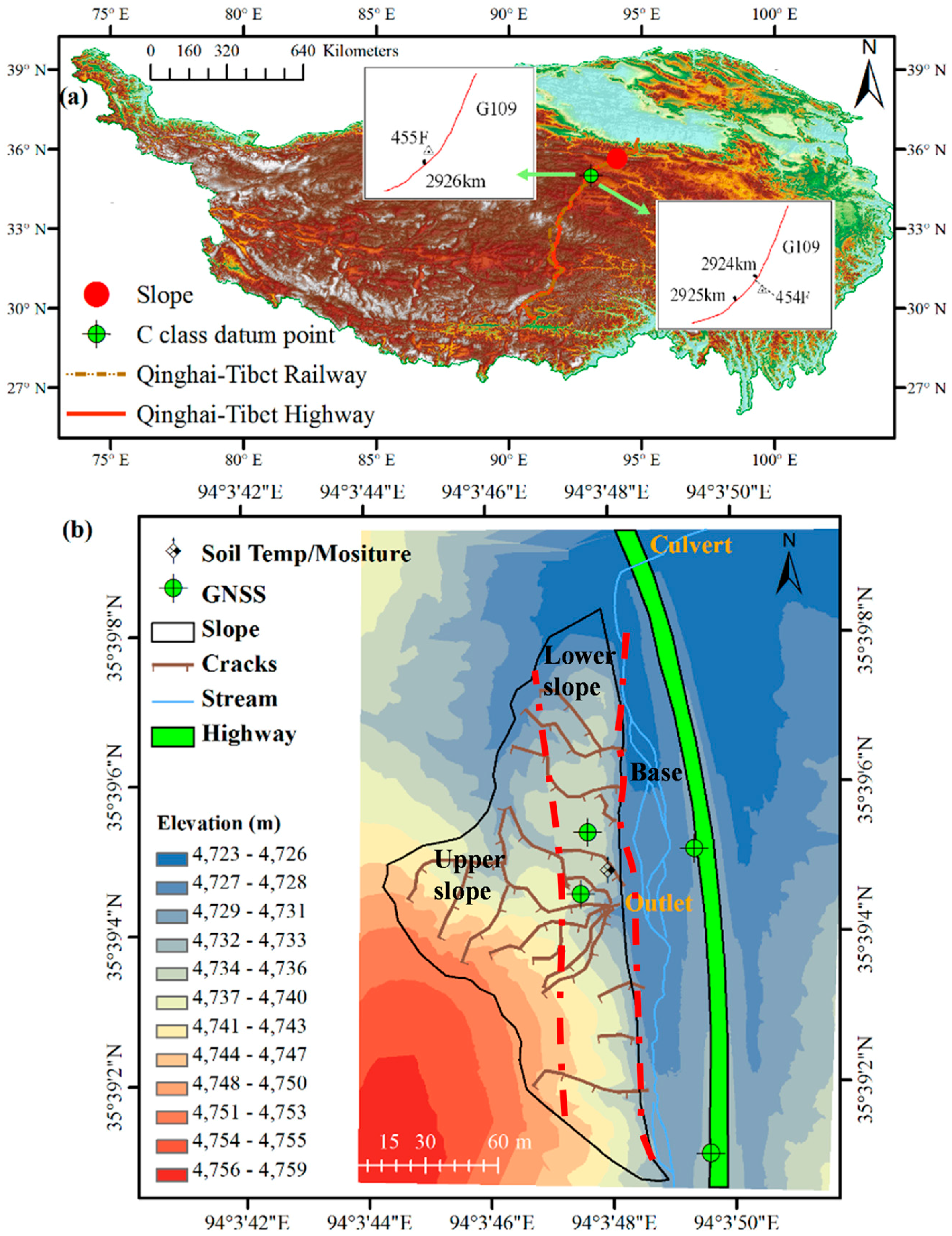
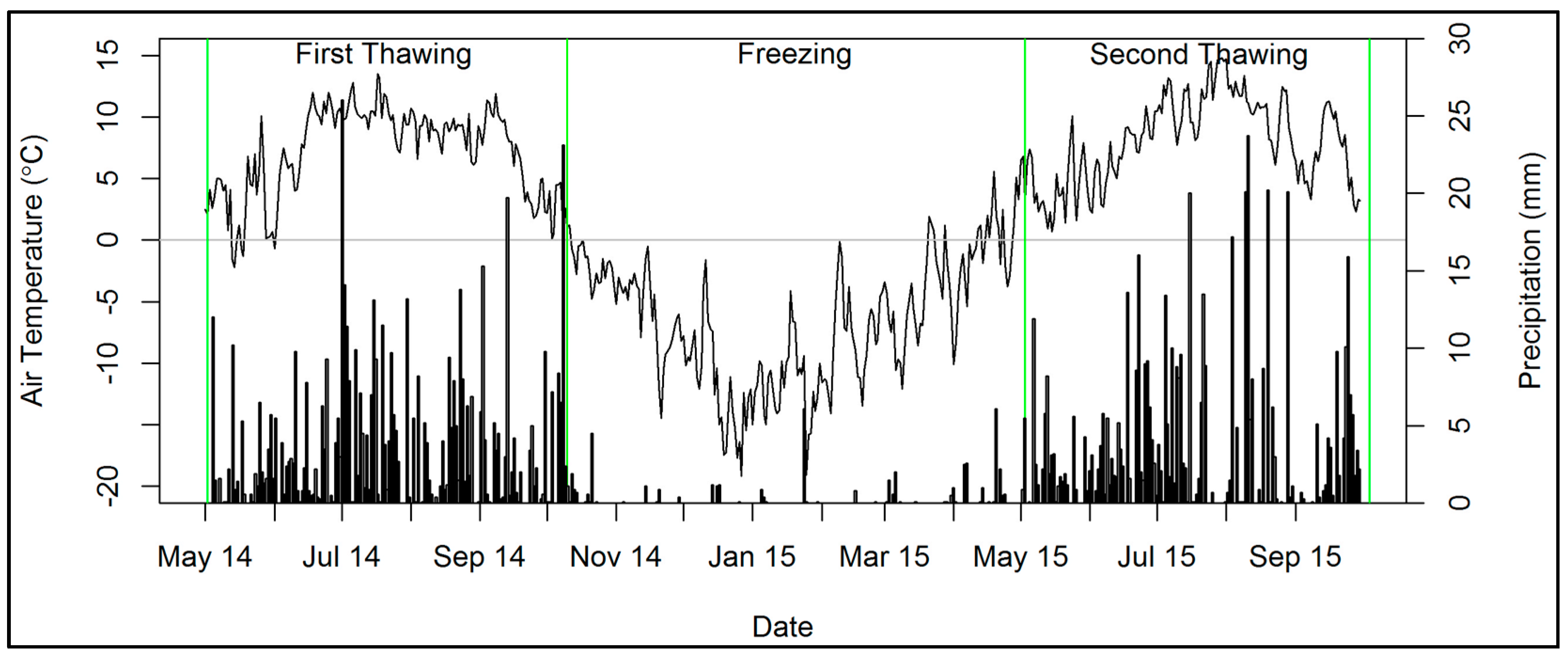
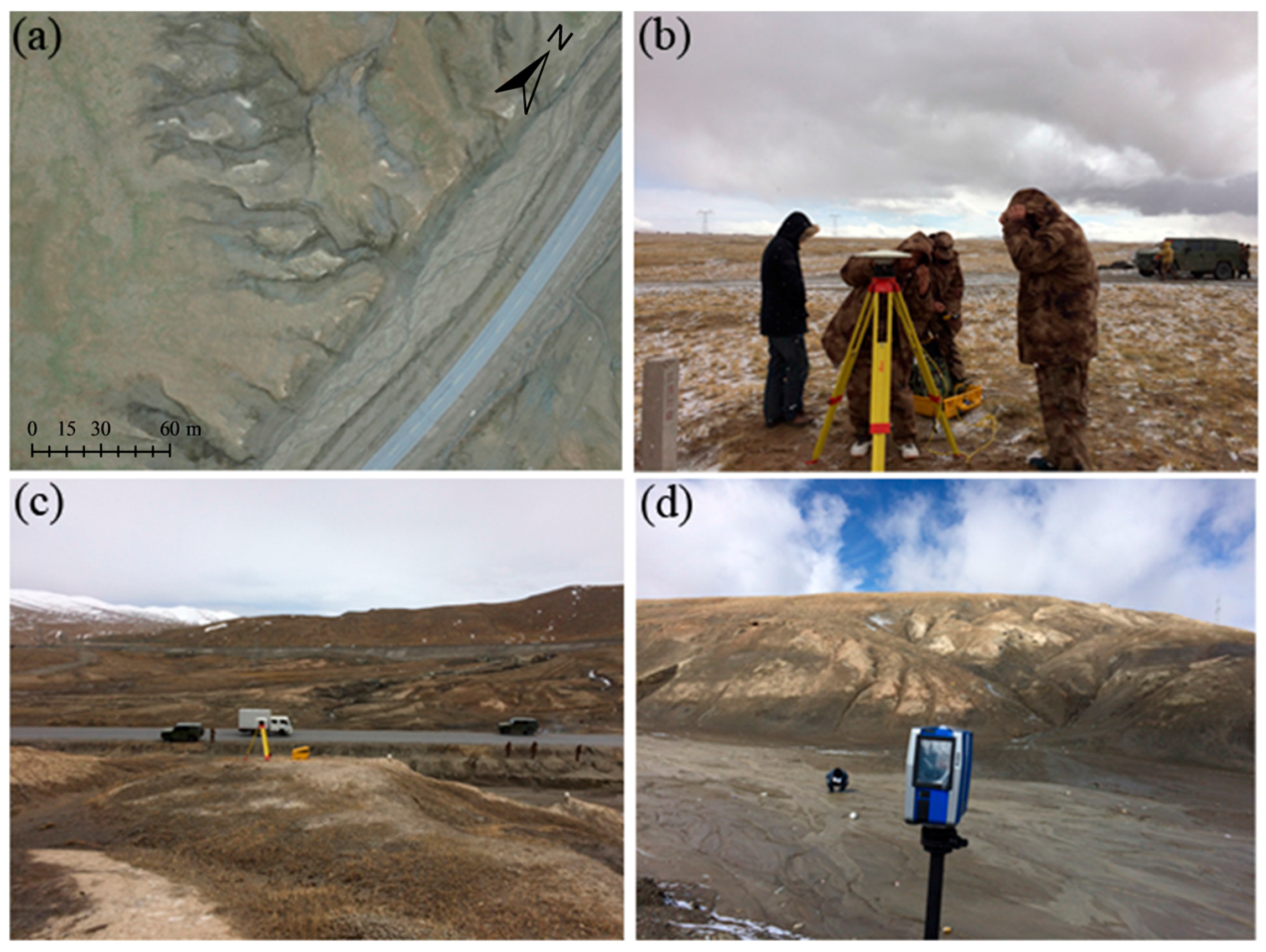
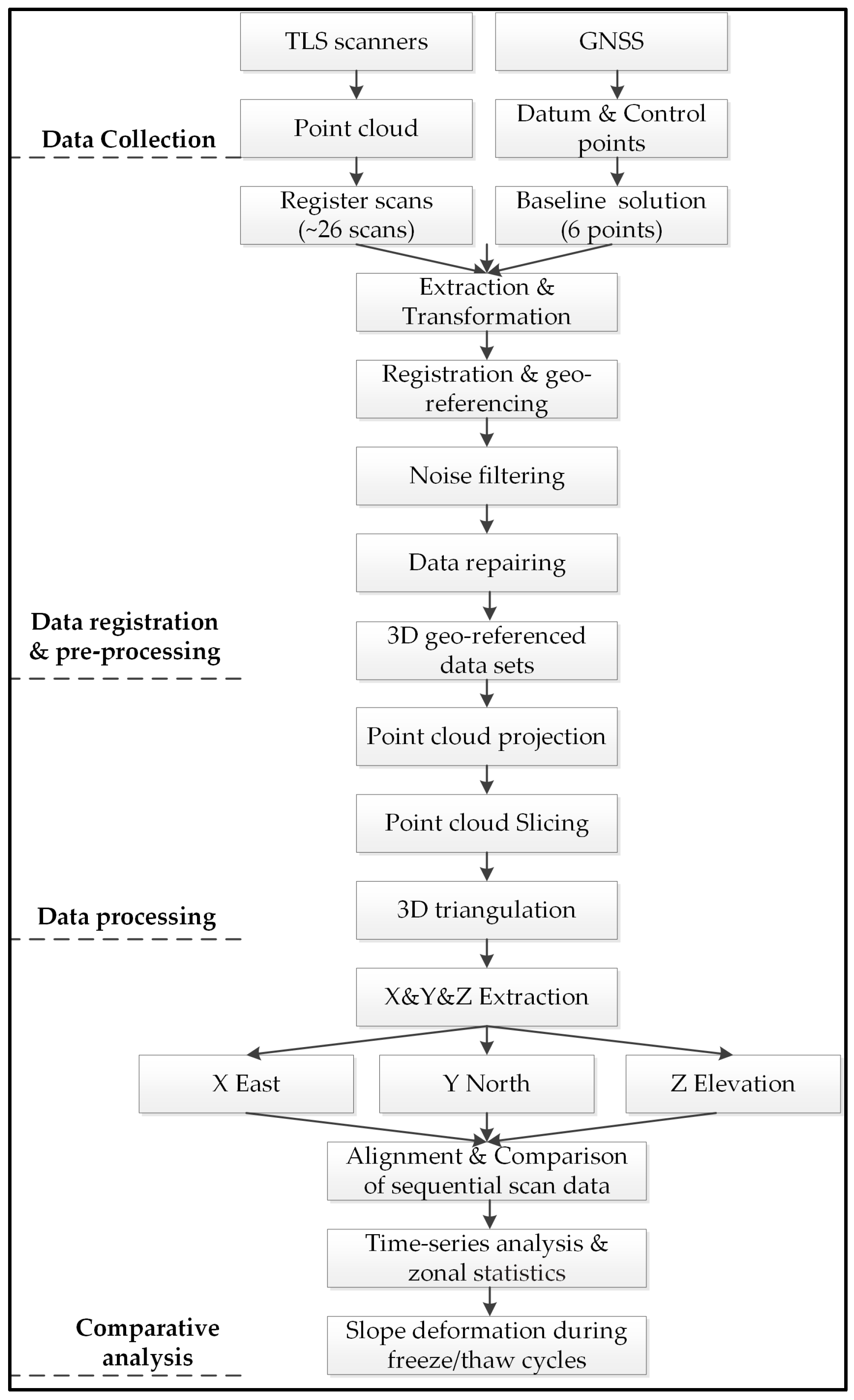

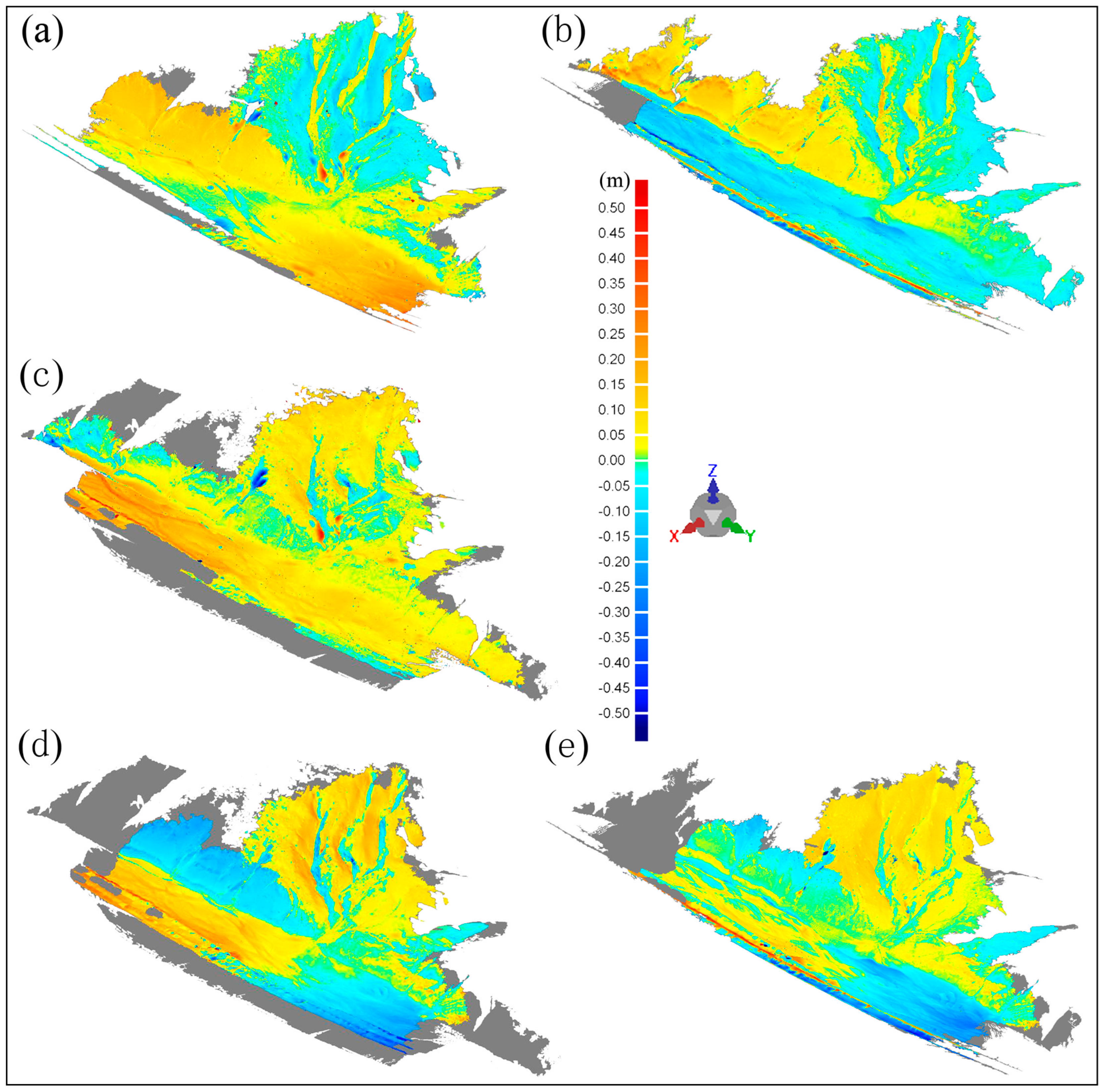
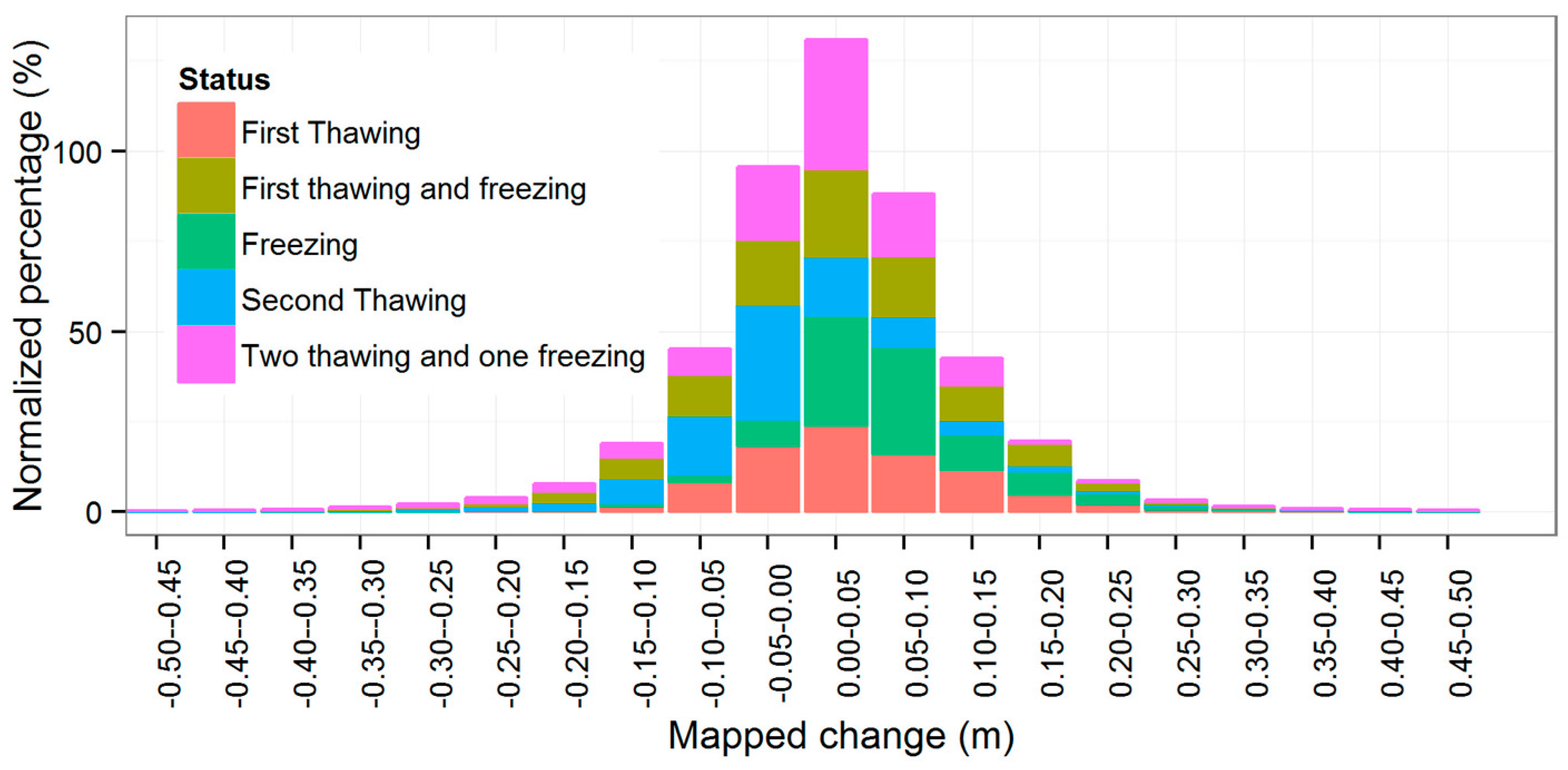
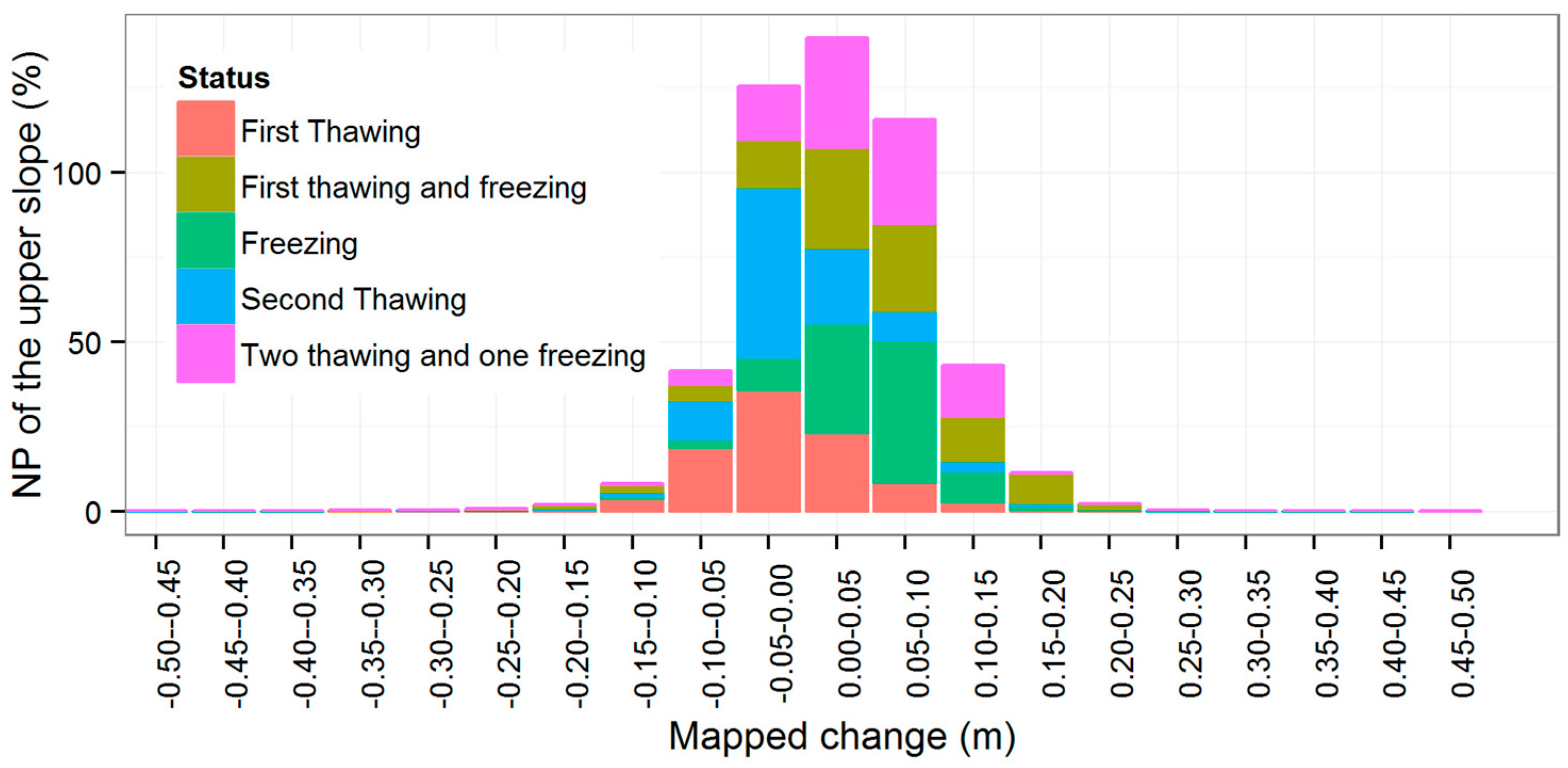
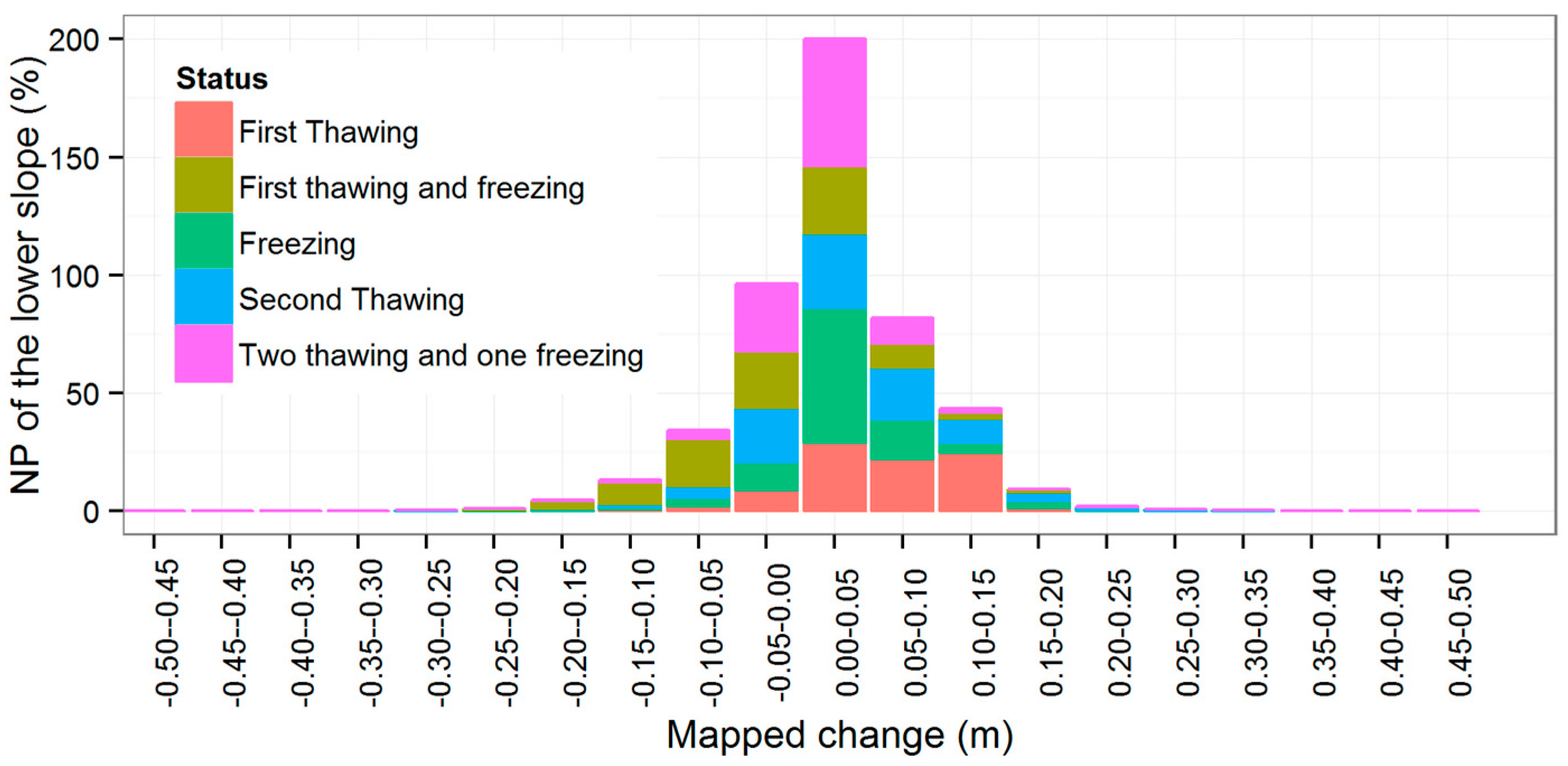
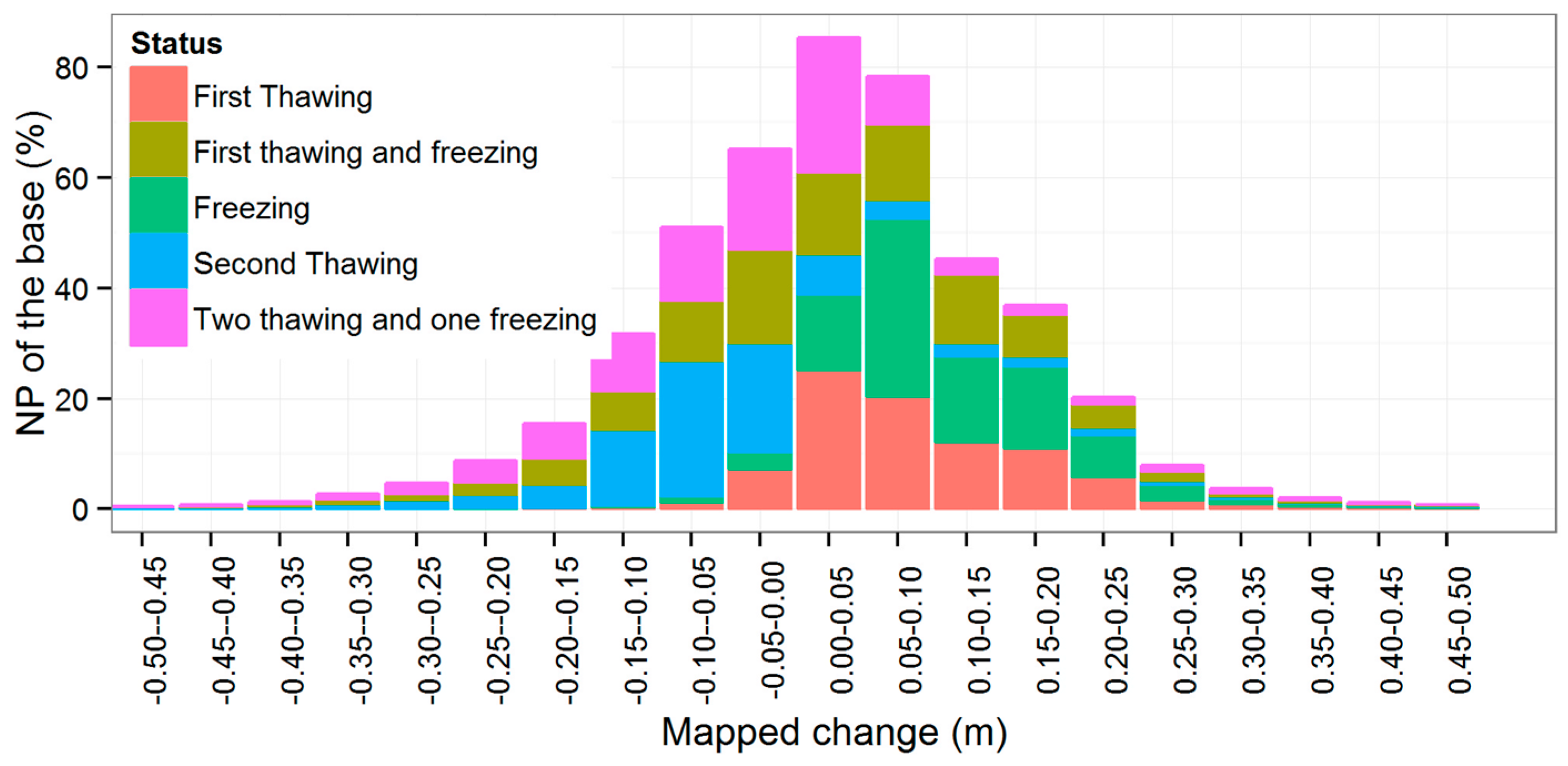

| Variable | Meaning | Unit | Value |
|---|---|---|---|
| ALT | Active layer thickness | m | 3.26; 3.34 |
| λt | Thermal conductivity of ground in thawed state | W/m°C | 0.98 |
| L | Latent heat of fusion | kJ/m3 | 1.17 × 105 |
| γ | Dry bulk density | kg/m3 | 870 |
| W | Soil water content in thawed state | % | 24 |
| Wu | Soil unfrozen water content in frozen state | % | 5 |
| Fa | Freezing degree-days for air | °C | 1493; 1485 |
| Fs | Freezing degree-days for ground | °C | 1066; 999 |
| Ta | Thawing degree-days for air | °C | 1218; 1277 |
| Ts | Thawing degree-days for ground | °C | 2202; 2310 |
| MAAT | Mean annual air temperature | °C | −0.75; −0.57 |
| MAGST | Mean annual ground surface temperature (5 cm) | °C | 3.11; 3.59 |
| Status | Time Span | Time Interval (days) | Mean Deviation (m) | Standard Deviation (m) | Data Points |
|---|---|---|---|---|---|
| First thawing | 2 May 2014–10 October 2014 | 161 | 0.30 | 1.09 | 1,251,706 |
| Freezing | 10 October 2014–3 May 2015 | 205 | 0.20 | 1.39 | 1,291,356 |
| Second thawing | 3 May 2015–4 October 2015 | 154 | 0.46 | 0.98 | 1,248,325 |
| First thawing and freezing | 2 May 2014–3 May 2015 | 366 | 0.08 | 0.10 | 1,278,448 |
| Two thawing and one freezing | 2 May 2014–4 October 2015 | 520 | 0.07 | 0.22 | 1,279,706 |
| Status | Distribution Percentage (Standard Deviation of x, Unit of Measurement: %) | |||||||||||
|---|---|---|---|---|---|---|---|---|---|---|---|---|
| x = −6 | x = −5 | x = −4 | x = −3 | x = −2 | x = −1 | x = 1 | x = 2 | x = 3 | x = 4 | x = 5 | x = 6 | |
| First thawing | 0.83 | 0.61 | 0.61 | 0.66 | 0.91 | 52.48 | 39.59 | 1.51 | 1.01 | 0.76 | 0.51 | 0.53 |
| Freezing | 1.03 | 0.66 | 0.78 | 0.81 | 0.60 | 4.53 | 89.51 | 0.51 | 0.43 | 0.35 | 0.31 | 0.48 |
| Second thawing | 0.33 | 0.26 | 0.50 | 0.63 | 1.07 | 76.68 | 16.66 | 0.88 | 0.73 | 0.65 | 0.54 | 1.07 |
| First thawing and freezing | 0.03 | 0.07 | 0.50 | 1.78 | 11.04 | 36.38 | 36.41 | 12.02 | 1.49 | 0.23 | 0.05 | 0.02 |
| Two thawing and one freezing | 0.41 | 0.07 | 0.10 | 0.17 | 2.09 | 37.23 | 58.30 | 1.18 | 0.11 | 0.07 | 0.05 | 0.23 |
| Zones | Status | Mean Deviation (m) | Standard Deviation (m) | Data Points |
|---|---|---|---|---|
| Upper slope | First thawing | 0.09 | 0.21 | 446,819 |
| Freezing | 0.07 | 0.08 | 447,599 | |
| Second thawing | 0.06 | 0.12 | 507,888 | |
| First thawing and freezing | 0.08 | 0.08 | 522,739 | |
| Two thawing and one freezing | 0.07 | 0.11 | 522,464 | |
| Lower slope | First thawing | 0.29 | 1.11 | 380,994 |
| Freezing | 0.05 | 0.07 | 328,711 | |
| Second thawing | 0.07 | 0.13 | 387,682 | |
| First thawing and freezing | 0.04 | 0.07 | 396,478 | |
| Two thawing and one freezing | 0.03 | 0.05 | 395,680 | |
| Base | First thawing | 0.31 | 1.19 | 430,174 |
| Freezing | 0.30 | 1.27 | 458,191 | |
| Second thawing | 1.10 | 1.28 | 459,395 | |
| First thawing and freezing | 0.11 | 0.13 | 431,209 | |
| Two thawing and one freezing | 0.09 | 0.33 | 431,289 |
© 2017 by the authors. Licensee MDPI, Basel, Switzerland. This article is an open access article distributed under the terms and conditions of the Creative Commons Attribution (CC BY) license ( http://creativecommons.org/licenses/by/4.0/).
Share and Cite
Luo, L.; Ma, W.; Zhang, Z.; Zhuang, Y.; Zhang, Y.; Yang, J.; Cao, X.; Liang, S.; Mu, Y. Freeze/Thaw-Induced Deformation Monitoring and Assessment of the Slope in Permafrost Based on Terrestrial Laser Scanner and GNSS. Remote Sens. 2017, 9, 198. https://doi.org/10.3390/rs9030198
Luo L, Ma W, Zhang Z, Zhuang Y, Zhang Y, Yang J, Cao X, Liang S, Mu Y. Freeze/Thaw-Induced Deformation Monitoring and Assessment of the Slope in Permafrost Based on Terrestrial Laser Scanner and GNSS. Remote Sensing. 2017; 9(3):198. https://doi.org/10.3390/rs9030198
Chicago/Turabian StyleLuo, Lihui, Wei Ma, Zhongqiong Zhang, Yanli Zhuang, Yaonan Zhang, Jinqiang Yang, Xuecheng Cao, Songtao Liang, and Yanhu Mu. 2017. "Freeze/Thaw-Induced Deformation Monitoring and Assessment of the Slope in Permafrost Based on Terrestrial Laser Scanner and GNSS" Remote Sensing 9, no. 3: 198. https://doi.org/10.3390/rs9030198







